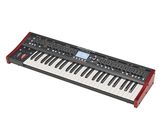The good:
The keybed is great, same keybed as the OB-6. Good feel even though I prefer the stiffer yamaha keybeds. Aftertouch has a controllable range.
Voice calibration is dead easy. VCF tuning may need occasional calibration if you use self-resonance for bell sounds, but this is a quick process.
There's very little menu diving. The most common controls are on the panel, and the most common options are on the first page of the menu. Lots of thought has gone into this and the result is easy to use.
Modulation is easy to set up. Hit mod button, pick mod slot, hold down mod button, nudge the source, nudge the destionation, adjust depth and done.
Envelopes have retrig. No note sequencer, but the arpeggiator is flexible and the control sequencer is useful. Control sequences can't be saved and shared across patches AFAIK, but arpeggio patterns can.
Preset management via the app is okay. Not the best, but far more convenient than faffing about with sysex.
The bad:
The second oscillator doesn't do a saw wave. In practice you can deal with this by using two voices in unison. This means the DM12 is definitely the one to get over the DM6, so you can still have six voice polyphony.
The volume of the patches is a bit all over the place, and you can't store main volume per patch, only VCA volume, which in turn changes the character of the sound. Volume can range 15dB or more between patches. Luckily the front panel volume knob is conveniently placed on the left hand control section.
The sound:
The bass sounds aren't the beefiest, you need to find a sweet spot to get truly nasty bass sounds. However, pads, arps and plucks are easy to make and sound great. Creating patches is a ton of fun and the sounds are inspiring. Most of the built-in patches are a bit naff, but if you know anything about subtractive synthesis it's dead easy to dive in and start building your own library.

